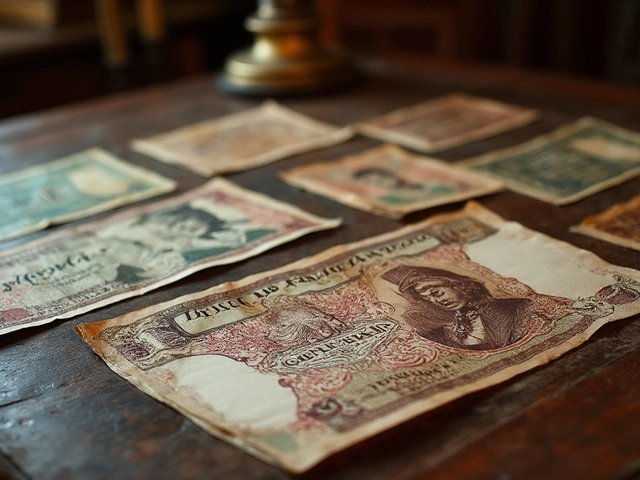Don't go looking for a £100 note in the UK—spoiler alert: it doesn't exist. Britain has stuck with its current banknote system for a while now, keeping things relatively simple. But why doesn't a hundred-pound note make it into people's wallets? Let's jump in and find out what's going on with British currency.
First things first, in the UK, common banknotes you'll find are £5, £10, £20, and £50. If you've ever traveled around here or watched a UK-based TV show, you might have noticed this yourself. No legal tender banknote worth more than £50 is in circulation. Curious, isn't it?
The reasoning behind these choices involves not just tradition but practical concerns, like counterfeiting. Higher denominations can be targets for fake replication, and keeping them out of general circulation helps minimize these risks. Stick around, there's a lot more to uncover about the history of British banknotes and currency culture!
- The Missing £100 Note
- Current UK Banknote Denominations
- History of British Banknotes
- Why No 100-Pound Note?
- Practical Tips for Handling UK Currency
The Missing £100 Note
If you're wondering why there's no £100 note in the UK, you're not alone. It's a question that puzzles many, especially those visiting or new to the British Isles, looking to understand UK currency. As far as banknotes go, the UK has chosen to stick to its guns with current denominations and has never officially issued a £100 banknote for general circulation.
Historical Preference
Throughout history, the UK's decision not to produce a £100 note might seem strange. However, it's primarily a matter of preference backed by economic and security reasons. The Bank of England, which issues these banknotes, aims to balance practicality with security. Simply, larger notes can invite unwanted attention from counterfeiters, and avoiding a higher denomination is one way to combat that.
Currency Efficiency
Another reason is efficiency in everyday transactions. Most transactions can be smoothly conducted with the current denominations, making a higher note somewhat redundant. Imagine pulling out a crisp £100 note at the local pub—it might not only raise eyebrows but also lack practicality for typical expenditures.
Impact of Inflation and Economy
Inflation over the years has raised questions about whether a higher denomination will ever be needed. But for now, the existing banknotes seem to do the job just fine. With digital payments soaring, some argue that cash's role, including that of a potential £100 note, might see itself dwindling in importance.
Whether traveling to the UK or simply keen on understanding British money, keep in mind that a hundred-pound note just isn't part of the picture. Stick with the familiar £50 and below, and you'll be well-equipped for your currency needs!
Current UK Banknote Denominations
When it comes to cash in the UK, there are some familiar faces—or should I say familiar figures—you'll see on banknotes. Unlike the mythical hundred-pound note, the UK has real, everyday denominations that everyone uses.
The Familiar Notes
Here's the lowdown: you'll typically handle four main banknotes. You have the £5, £10, £20, and £50 notes, each featuring significant figures from British history. The £5 note, for instance, showcases Winston Churchill. Feeling a bit posh with your tenner? Jane Austen graces the £10 note. The £20 and £50 notes feature economist Adam Smith and artist J.M.W. Turner, respectively. Each of these notes brings a little touch of British heritage with them.
Why no £100, you might ask? It's partly tradition—but also practicality. Even the £50 note isn't as common as the others. Many locals prefer smaller denominations because they're easier to use for everyday transactions.
Plastic Money
Another interesting thing is that UK notes aren't just paper anymore. Following the trend for more secure and durable money, the UK switched to polymer notes in recent years. They're more resilient and have advanced security features to deter counterfeiting.

History of British Banknotes
Let's roll back the clock to the late 17th century when the British banknote story began. The first banknotes were issued by the Bank of England shortly after it was founded in 1694. These early notes weren't as uniform as today's cash. Instead, they were hand-signed and made out for varied amounts—not the most practical form of currency, right?
The Evolution of Banknotes
Fast forward to the 18th and 19th centuries, and you start seeing some changes. Notes became printed instead of handwritten, making them more recognizable and easier to use. Early banknotes were sometimes issued by various banks, but a law in 1844 cracked down on this, leaving the Bank of England as the primary note issuer.
20th Century Changes
As we hit the 20th century, technology and design advanced. The modern look of UK banknotes was coming together, with safety features added to deter counterfeiters—a constant battle with crooks, it seems. It's also around this time that denominations standardized with the familiar £5, £10, and £20 notes taking center stage.
Recent Developments
In recent years, the UK has gone a step further to ensure note security. Polymer banknotes were introduced, known for their slick feel and durability. The new material has drastically reduced note wear and tear while keeping them secure against fraud. The polymer £5 note appeared in 2016, followed by various other denominations.
Through these changes, the UK has held on tight to a setup that excludes the hundred-pound note. It appears the blend of history, tradition, and security is a potent mix keeping things just as they are.
Why No 100-Pound Note?
So, why isn't there a £100 note kicking around in the UK? This isn't just a random choice—there's some method to the madness! Let's break it down.
Keeping It Practical
One big reason is practicality. Smaller denominations, like the UK currency notes we see today (£5, £10, £20, and £50), are way easier for everyday transactions. Imagine trying to pay for a cup of coffee with a £100 note! It would be pretty inconvenient, right?
The Counterfeit Factor
Another driving factor is the risk of counterfeiting. Higher-denomination notes are prime targets for forgery. This doesn't just affect the holders of fake notes—it impacts businesses forced to accept currency they then can't deposit anywhere. By sticking with lower denominations, the UK aims to keep essential aspects of its economy just a little bit safer.
Staying Modern
Digital payments are more popular now than ever. Many people rely on contactless cards or digital payment platforms. With less demand for high-value cash, introducing something like a 100-pound note may not make much sense financially.
Understandably, this could make someone from outside the UK a bit puzzled. After all, many countries do have high-denomination notes. But here in the UK, practicality, safety, and adapting to modern times take the front seat—leaving the hundred-pounder in the realm of 'what if.' Next time you grab some cash in Britain, you'll know exactly why your wallet isn't weighed down by a £100 note!

Practical Tips for Handling UK Currency
Visiting the UK or just handling British money for the first time? Don't worry, it's not as tricky as it might seem. Here are some tips to make your experience smoother.
Know Your Notes
Familiarize yourself with the common banknote denominations: £5, £10, £20, and £50. Each note showcases a different historical figure or symbol, making them unique. You won't find a hundred-pound note in circulation, so don't waste time searching for it.
Coin System
Besides notes, the UK has coins for smaller amounts. Be ready for these coins:
- 1p, 2p - Copper coins, great for small change.
- 5p, 10p, 20p, 50p - Silver-colored coins, often handy for minor expenses.
- £1, £2 - Larger coins, used frequently for vending machines and smaller purchases.
Using ATMs
ATMs, also known as cashpoints, are widely available, and most accept international cards. Just be sure to check any fees that might apply when withdrawing cash using a foreign card.
Contactless Payments
In the UK, contactless payment is very popular. Most places allow you to pay quickly by tapping your card or smartphone. It's a convenient option especially since the spending limit has been recently increased to £100.
Currency Exchange
Looking to exchange currency? Banks and bureau de change offices are reliable options, although rates and fees can vary, so it's wise to shop around for the best deal.
Keep an Eye on Currency Values
Watch out for fluctuating exchange rates if you're converting from foreign currency. Websites and apps offer real-time updates, so you can decide the best time to exchange.






